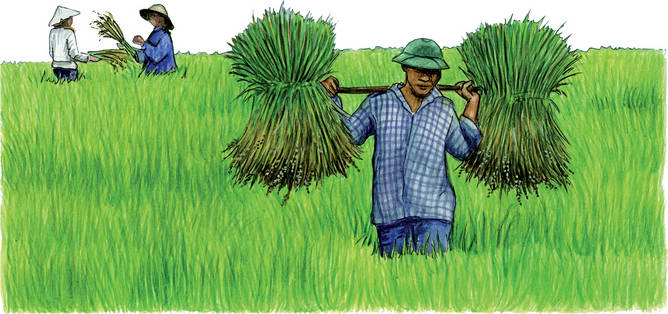Farming systems that ‘#SaveandGrow’ – in pictures

Maize, rice and wheat are fundamental to world food security. We must safeguard production in the world’s grain belts and rice bowls, and increase yields in countries where production has to substantially improve as populations grow. Climate change adds new pressures on cereals, including rising temperatures and a higher incidence of pests, diseases, droughts and floods.
FAO’s model of ecosystem-based agriculture, Save and Grow, meets that need, through farming systems that incorporate conservation agriculture, healthy soils, improved crops and varieties, efficient use of water, and integrated pest management. The below examples, taken from countries around the world, describe Save and Grow farming systems in practice.
Higher yields from healthy plants in healthy soil - Rice, Asia
From widely-spaced plants in aerated soil, the System of Rice Intensification (SRI) has produced yields double those of flooded rice fields. Its focus on soil health improves the rice plant’s access to nutrients, while its reduced irrigation needs help cut methane emissions. The system’s higher labour requirements could be lowered with technological innovation.
The ‘slash-and mulch’ system grows maize and beans on untilled soil enriched with tree prunings. It builds soil nutrient stocks, reduces the time needed for land preparation and weeding, and produces yields double those of traditional shifting cultivation. Many ‘slash-and-mulch’ farmers have diversified production into home gardens and livestock.
The extra benefits of legumes before wheat - Wheat/ legumes worldwide
Legume residues add to soil up to 300 kg of nitrogen per hectare. As a result, wheat grown after legumes produces higher grain yields, with higher protein content. In addition, some legumes secrete acids that make phosphorus more readily available to the wheat’s roots, and a gas that improves the plant’s overall development.
In South Asia’s breadbasket, farmers practice zero-tillage to reduce costs and grow more wheat. Alternate wetting and drying of rice fields helps cut water consumption by up to 50 percent. Yields of both cereals improve after laser-assisted land-levelling. Farmers save on fertilizer with ‘needs-based’ nitrogen management and use legumes to suppress weeds.
A novel system of integrated pest management harnesses chemical interactions between two local plants to destroy maize stem borers and impede the growth of Striga weed. As well as providing year round soil cover, the system produces high quality fodder, making ‘push-pull’ the basis for sustainable, low-input crop/livestock production.
A key component of sustainable maize-livestock systems is Brachiaria pasture, which prevents soil compaction and is more nourishing than native savanna grasses. Zero-tillage systems that use the grass produce up to three cereal crops a year. Relay cropping Brachiaria with maize makes optimal use of land resources and reduces land degradation.
A one-hectare paddy can yield up to 9 tonnes of rice and 750 kg of fish a year. Fish raised in rice fields improve family diets and provide a natural source of plant nutrients and pest control. Thanks to higher rice yields, fish sales and savings on agrochemicals, the income from rice-fish farming is up to 400 percent more than that from rice monoculture.
Leguminous shrubs and trees are an integral part of maize production systems in Zambia and Malawi. Over two years, they increase levels of soil nitrogen by as much as 250 kg per hectare, which helps quadruple maize output. The maize/ forestry system is resilient to drought and more profitable than growing maize with fertilizer.









Facebook comments